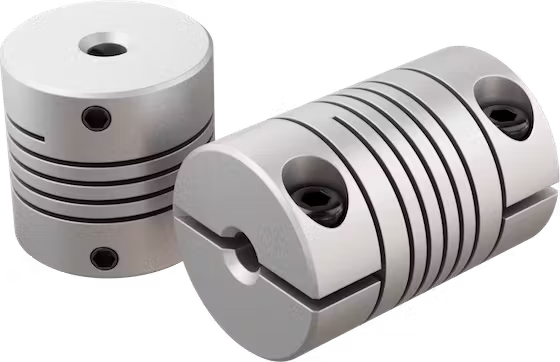“`html
Introduction to Beam Coupling
Beam couplings, also known as helical couplings, are mechanical devices designed to transmit torque between two shafts while accommodating for various types of misalignment. They are an essential component in a wide range of industrial applications, including generators. In this section, we’ll explore the design, applications, and key features of beam couplings.
Design and Construction
Beam couplings are characterized by their helical cut design, which provides a balance between flexibility and torsional stiffness. This design enables the coupling to compensate for axial, radial, and angular misalignments between connected shafts without sacrificing torque transmission capabilities.
Applications in Generators
In the context of generators, beam couplings are used to connect the generator’s shaft to the engine or motor that drives it. This connection is crucial for the efficient and reliable operation of the generator, as it ensures smooth torque transmission even in the presence of misalignment.
Key Features

- High flexibility and adaptability to misalignment
- Zero backlash operation, ensuring precise torque transmission
- Maintenance-free, with no need for lubrication
- Durable construction, capable of withstanding harsh operating conditions
Advantages of Beam Coupling for Generators
Beam couplings offer several advantages when used in generator applications. Here are five key benefits:
1. Enhanced Performance
By efficiently handling misalignments, beam couplings ensure smooth and efficient operation of generators, leading to enhanced overall performance.
2. Reduced Wear and Tear
The flexibility of beam couplings minimizes the stress on connected components, reducing wear and tear and extending the lifespan of both the coupling and the generator.
3. Easy Installation
Beam couplings are designed for easy installation and alignment, reducing downtime and simplifying maintenance processes.
4. High Torque Capacity
Despite their compact size, beam couplings are capable of transmitting high levels of torque, making them suitable for powerful generator applications.
5. Vibration Damping
The helical design of beam couplings provides natural vibration damping, contributing to the smooth operation and longevity of the generator.
How Beam Couplings Work
Beam couplings transmit torque through a helical cut pattern in a single piece of material. This section explains the working principle in three parts:
The helical cuts in the coupling allow it to flex under load, accommodating misalignment while maintaining a strong grip on the connected shafts. This flexibility enables the coupling to compensate for axial, radial, and angular misalignments.
As torque is applied, the helical design distributes the load evenly across the coupling, minimizing stress concentrations and allowing for smooth torque transmission.
The inherent stiffness of the material, combined with the helical design, ensures that the coupling can transmit torque efficiently without significant loss of energy, even while compensating for misalignment.
Selecting the Right Beam Coupling
Choosing the appropriate beam coupling for a generator involves several key considerations:
1. Torque Requirement
It’s crucial to select a coupling with a torque capacity that matches or exceeds the generator’s requirements.
2. Shaft Size and Type

The coupling must be compatible with the sizes and types of shafts used in the generator and the driving motor or engine.
3. Misalignment Tolerance
Consider the types and degrees of misalignment expected in the application to ensure the coupling can accommodate them without performance loss.
4. Environmental Conditions
The coupling should be suitable for the operating environment, including temperature, humidity, and exposure to corrosive substances.
5. Space Constraints
Beam couplings come in various sizes and configurations. Select one that fits within the available space without compromising performance.
Maintenance of Beam Coupling
Maintenance of beam couplings is minimal, making them an attractive option for generators. However, regular inspections should be conducted to ensure there are no signs of wear or damage. Keeping the coupling clean and free from debris will also help maintain its performance and longevity. The importance of maintenance cannot be overstressed, as it ensures the efficient and reliable operation of the generator.
About HZPT

Established in 2006, HZPT is a leading manufacturer and exporter specializing in the design, development, and production of couplings. With 16 years of experience, our in-house design and R&D team can customize products to meet global customer requirements. We boast a comprehensive quality control system, from raw materials to finished products, ensuring that all our products, including our beam couplings for generators, meet the highest standards with CE and TUV certifications. Our commitment to customer satisfaction, high-quality products, and competitive pricing has earned us a reputable standing in the European and American markets. Choose HZPT for the best in service, quality, and value. We look forward to cooperating with you and establishing a successful business relationship in the near future.
“`
